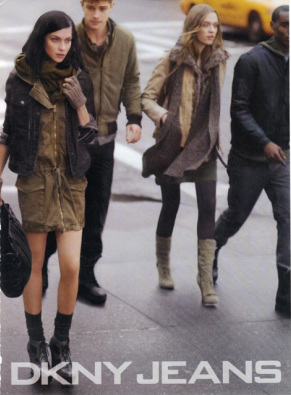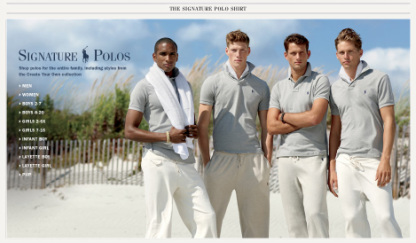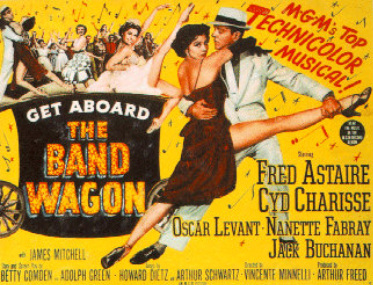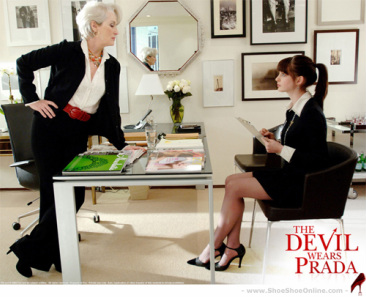Bandwagons in Fashion
Brooke Jurewicz

For years, producers have been appealing to consumers’ wants and desires
through advertising. Not every customer searches for the same things in
this world filled with millions of products. A producer must be smart
in how they present their product to the buying industry.
Compared to the pressure of the producer, there is ten times more
pressure on the consumer. The purpose of clothing goes much further than
just providing ‘warmth and protection’. Our society holds a high
standard for what fashion should or should not be. Clothes tell how
important an individual person is. It shows their social status, their
identity, how they should be treated, their personality, and usually,
their income. Sometimes it may seem that we, the consumers, are the ones
who drive the producers’ thoughts and ideas in society. With all the
pressure in the fashion industry, a consumer is most likely to view
fashion advertisements and jump on the ‘bandwagon’ preventing their
becoming a social fashion outcast.
The drive for American’s to reach a certain fashion image is everywhere: movies, television, magazines, radio, and the internet.The Bandwagon fad became even more popular after "A Technicolor Musical" like Get Aboard the Bandwagon starring Fred Astaire debuted in 1953. For example, the movie 2006The Devil Wears Prada, starring Meryl Streep and Anne Hathaway, displays the need to stay atop the fashion world. It is hard to escape the set standards. Fashion, in and of itself, is one giant bandwagon. The desire to be accepted into society as an admired being is a goal most aspire to reach. You are either on the bandwagon, or you aren’t. Like stated on the famous blog “Little Pink Book”, “The elite world of fashion is the land of dog eat dog. You either keep up with the pack of you are eaten alive” (Little Pink Blog). While attempting to keep up with the fashion norms, we consciously fall for advertisements telling us what to wear. Ads all over tell us the new trend, and how everyone will be wearing it and that we should too.
The drive for American’s to reach a certain fashion image is everywhere: movies, television, magazines, radio, and the internet.The Bandwagon fad became even more popular after "A Technicolor Musical" like Get Aboard the Bandwagon starring Fred Astaire debuted in 1953. For example, the movie 2006The Devil Wears Prada, starring Meryl Streep and Anne Hathaway, displays the need to stay atop the fashion world. It is hard to escape the set standards. Fashion, in and of itself, is one giant bandwagon. The desire to be accepted into society as an admired being is a goal most aspire to reach. You are either on the bandwagon, or you aren’t. Like stated on the famous blog “Little Pink Book”, “The elite world of fashion is the land of dog eat dog. You either keep up with the pack of you are eaten alive” (Little Pink Blog). While attempting to keep up with the fashion norms, we consciously fall for advertisements telling us what to wear. Ads all over tell us the new trend, and how everyone will be wearing it and that we should too.

The bandwagon advertising technique
is widely used in all industries. Especially in fashion, advertisers take a
subtle approach, but the main message always pulls through: “Wear this and you
will be cool, just like everyone else.” The advertisers use the psychological
aspects, hoping consumers won’t want to be left out; and indeed they are
correct. The consumers want to buy and wear what everyone else is wearing. The
advertisers use precisely the right image to persuade consumers to purchase
their products, in hope of them wanting to achieve a fashionable status. In Marie Claire, an advertisement for DKNY
Jeans jumped out at me and screamed “Bandwagon!” The ad features 6 male and
female models on a street in what looks like a metropolitan area. All the
models are wearing DKNY’s new line “Urban Boot Camp” in military hues of dark
green, khaki, and black, walking down the street together. DKNY is portraying
the selected colors as being “in” at the moment. Every model is wearing,
basically, the same thing signifying the accepted crowd is wearing those colors
and types of clothes. The models are
thin and what society portrays as “beautiful”. The buyer may think that they
will be pretty and cool since “that’s what everyone else is doing” and the
image in the ad displays this concept perfectly.

Another designer famous for using the bandwagon technique is Polo Ralph Lauren. In this specific ad, Polo Ralph Lauren places beautiful male models all in the same exact relaxed beach-like outfit. In their signature gray polo shirt and with comfortable drawstring pants, not only do they look extremely attractive, but they also look relaxed and in control. All these good looking men, with their clean shaven faces and piercing eyes, are wearing the Polo Ralph Lauren clothing, and unwinding at the beach. The ad signifies if you are of high social status, rolling in the money, and very attractive then you, most likely, would be doing the same thing. With Polo Ralph Lauren’s ever so famous symbol of the polo horse on their shirts, simply by their bandwagon technique working, their name and product only gets bigger through others wearing and branding themselves in this “polo” symbol.

In another Ralph Lauren ad, found online, the models are advertising for winter apparel. In this ad, their winter apparel is supporting the United States Olympic Games. All six models are wearing white pants with “2010” printed on them, huge down coats featured in colors red, white, and blue, and also beanie hats with American patriotic symbols displayed on it. The models are thin- the guys with chiseled cheek bones, girls with legs that extend to South America. In this ad, the bandwagon technique is also used in a patriotic way. It’s a way of saying “The American Olympic team is using our product, so why aren’t you?” By supporting America in the Olympics, it is a very wise advantage on their product convincing consumers to buy it. The ad features the Olympic flag in the background which helps us view this product in a more respected way than those not supporting the Olympics.

Clothes from American Eagle Outfitters are also very widely purchased products. It is supremely famous among teenagers starting around the age of 13. At that age, one is influenced by the slightest thing. “Everyone is doing it, so why shouldn’t I” is the thought process of a 13 year old. The need to fit in is at its all-time high at that age; if you don’t have the “in” clothes, you won’t be considered “in” (Boston). American Eagle’s advertisements are simple, but they get the point across: “Wear our clothes, and you will be popular.” This particular ad, found online, displays different activities. One portion of the ad features relaxation. Another features young, attractive friends having fun and being silly. The most prominent picture on the ad is a pile-up of all the friends up close smiling and looking like they are enjoying their time together. The ad says “True Friends. True Fashion. AE.” While pleasant to the eye, one would assume that in order to have “true friends” you must wear their “true fashion”. This is very misleading especially to the age group it is designed for. But it is just one more time that the bandwagon technique will succeed (Boston).
Everyone wants to be on the bandwagon. It’s a desire that has always been present- to be accepted, to be popular. Marketing and advertisers use any techniques possible just to get their names out there. Fashion is a very competitive business and producers will do anything they can to sell. Whether American Eagle is appealing to teenagers insecurities, DKNY appealing to uniformity, or Polo focusing on models with good looks and uniformity, the bandwagon affect is astronomical. Everyone just wants to do what everyone else is doing; they want to be accepted. Consumers will do anything it takes to stay alive in this dog eat dog fashion world.
Everyone wants to be on the bandwagon. It’s a desire that has always been present- to be accepted, to be popular. Marketing and advertisers use any techniques possible just to get their names out there. Fashion is a very competitive business and producers will do anything they can to sell. Whether American Eagle is appealing to teenagers insecurities, DKNY appealing to uniformity, or Polo focusing on models with good looks and uniformity, the bandwagon affect is astronomical. Everyone just wants to do what everyone else is doing; they want to be accepted. Consumers will do anything it takes to stay alive in this dog eat dog fashion world.
Works Cited
Boston, Gabriella. "Designed to Fit In; Teen Fashion Defined by Peer Pressure. | Goliath Business News." Goliath: Business Knowledge On Demand. Web. 01 Mar. 2011. http://goliath.ecnext.com/coms2/gi_0199-3140560/Designed-to-fit-in-Teen.html
"{iStyle} Industry Standard for the Fashionably Fierce and Notably Nasty...Or NOT? | Little Pink Blog." Web. 01 Mar. 2011.<http://sashahalima.com/blog/2010/08/istyle-industry-standard-for-the-fashionably-fierce-and-notably-nasty-or-not/>.
"{iStyle} Industry Standard for the Fashionably Fierce and Notably Nasty...Or NOT? | Little Pink Blog." Web. 01 Mar. 2011.<http://sashahalima.com/blog/2010/08/istyle-industry-standard-for-the-fashionably-fierce-and-notably-nasty-or-not/>.


